The iconic silhouette of a Stratocaster represents a piece of musical history finely tuned for both aesthetics and playability. The dimensions of a Stratocaster body, crafted with precision, contribute significantly to its distinct sound and comfortable handling.
Fender, the pioneering company behind this legendary guitar, has maintained a standard body length of 15.5 inches, a width of 12.75 inches, and a depth of 1.75 inches, with slight variations between models. The full length from the top of the headstock to the bottom of the body measures an elegant 38.75 inches, ensuring a balanced instrument both in hand and against the body.
These carefully designed proportions collaborate to offer the famous ergonomic comfort and sonic versatility that have solidified the Stratocaster’s status as an indispensable tool for guitarists across genres and playing styles.
Key Takeaways:
- The dimensions of a Stratocaster are carefully designed for optimal playability and comfort, with a standard body length of 15.5 inches, width of 12.75 inches, and depth of 1.75 inches.
- The full length of a Stratocaster, from the top of the headstock to the bottom of the body, is typically 38.75 inches, ensuring a balanced instrument both in hand and against the body.
- Stratocaster necks usually have nut widths ranging from 41mm (1.61″) to 44mm (1.73″), which can significantly affect playability and comfort for different hand sizes.
- The contoured body shape of the Stratocaster, a hallmark of its design, contributes to both its iconic look and ergonomic comfort for players.
- While standard dimensions exist, slight variations can occur between models, and custom options allow for personalization of wood types, finishes, and pickup configurations to suit individual preferences.
Related: The Dimensions of a Telecaster Body
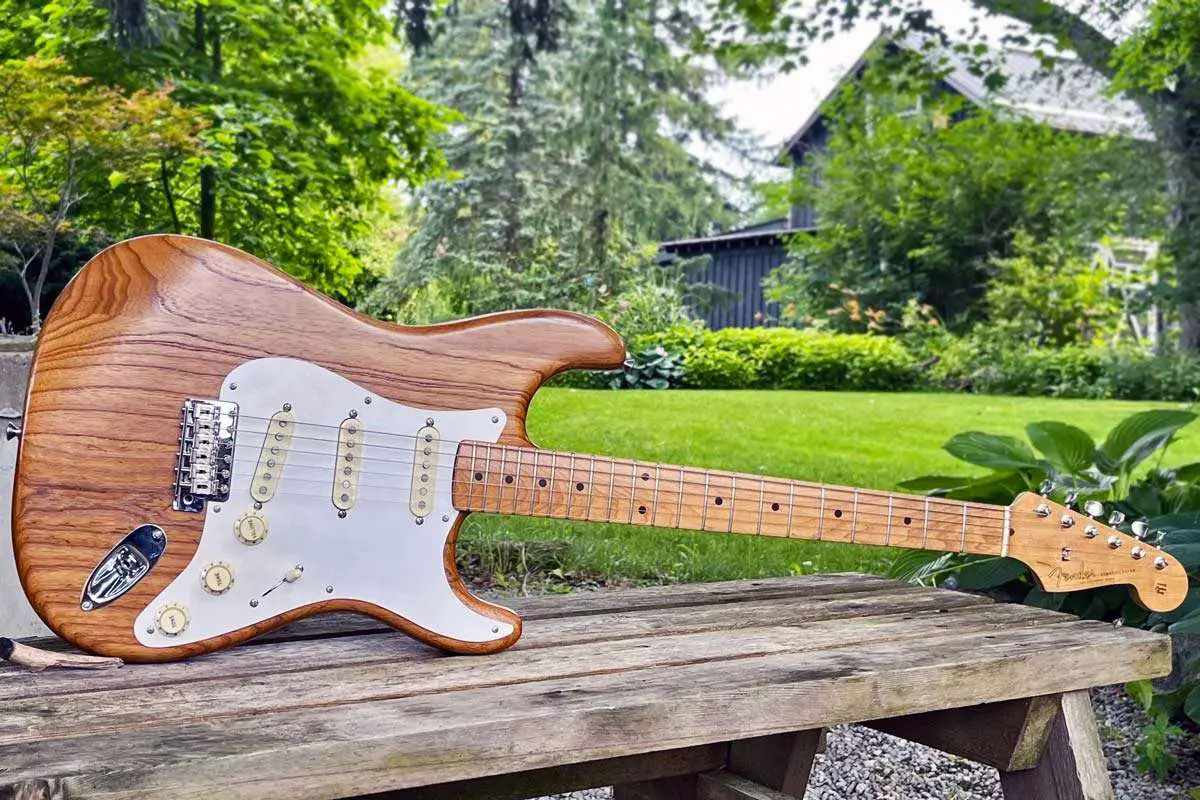
Historical Context of the Stratocaster
The Fender Stratocaster has a storied past that revolutionized the electric guitar industry. Your understanding of its dimensions is incomplete without appreciating its rich history and the role it played in shaping music.
Early Design and Development
The inception of the Stratocaster in 1954 marked a significant milestone for Fender and the electric guitar world. Birthed by the collaborative genius of Leo Fender, George Fullerton, and Freddie Tavares, its design was a bold departure from the Telecaster. The double cutaway body not only improved the aesthetics but also provided easier access to the higher frets.
Evolution Over the Years
Through the years, the Strat’s dimensions have seen subtle but impactful changes. Initially, specs variances were common as Fender honed its iconic model. Over time, the dimensions of a stratocaster body evolved to a standard 15.5″ x 12.75″ x 1.75″ with a full length of 38.75″, mastering a balance of comfort and sound quality while keeping the distinctive contoured body shape that it’s known for.
Impact on Electric Guitar Industry
The impact of the Stratocaster on the electric guitar industry cannot be overstated. In its wake, the Strat fostered a new era of guitar design and music. Fender’s Stratocaster became a symbol of innovation, setting the standard for electric guitar construction and aesthetics, influencing countless musicians and luthiers around the globe.
Related: Famous Stratocaster Players
Anatomy of the Stratocaster Body
When you’re looking to understand a Stratocaster, it’s important to examine its material composition, standard dimensions, and signature contours that contribute to its unmistakable look and feel.
Related: The Anatomy of an Electric Guitar
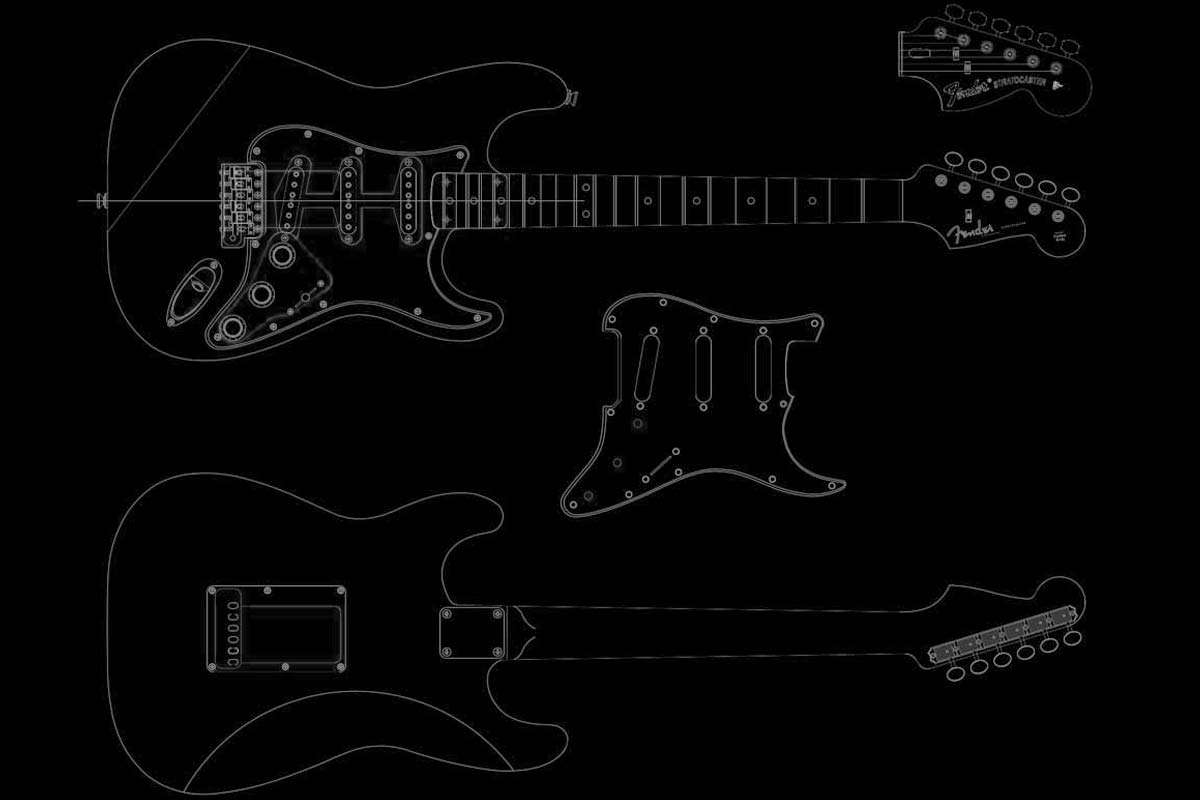
Material Composition
The Stratocaster is synonymous with tonewoods like Alder or Swamp Ash, each chosen for their acoustic properties and contribution to the guitar’s overall tone. Alder is widely appreciated for its balanced sound, while Swamp Ash offers a brighter and more resonant tone. Both are coated with a Poly (polyurethane) finish providing a protective layer that enhances durability and aesthetics.
Standard Body Dimensions
Your typical dimensions of a Stratocaster body will measure approximately 18.1 inches (461mm) in length and 12.7 inches (323mm) in width. However, these dimensions can slightly vary between models. The depth is usually around 1.75 inches if you’re considering a standard model. These dimensions are critical as they impact the guitar’s balance and player comfort.
Contours and Curves
The body of your Stratocaster is designed with player comfort in mind, sporting elegant contours and curves that facilitate playability. These indulgent curves are not just a hallmark of style but also serve the practical purpose of hugging the player’s body. The precise crafting of these contours is what sets the Stratocaster apart from other guitar bodies, as they enable freedom of movement and ease of access across the fretboard.
Neck Pocket Specifications
The neck pocket of a Stratocaster is critical for ensuring proper guitar assembly and playability. Its dimensions are carefully measured to fit a specific range of neck sizes.
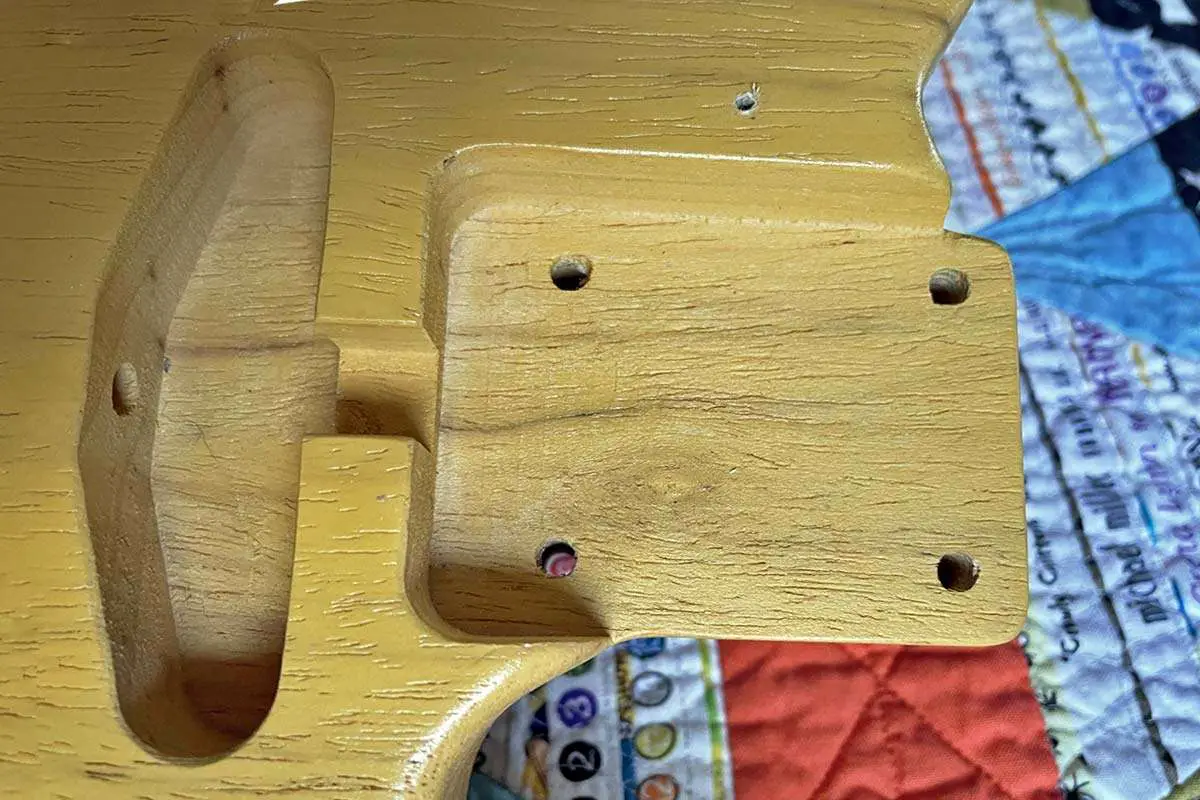
Dimensions and Tolerance
The standard neck pocket on a Stratocaster should measure approximately 3 inches (76mm) in length, ⅝ inch (15.88mm) in depth, and 2 3/16 inches (55.56mm) in width. The tolerances for these measurements are quite tight because a precise fit is crucial for maintaining the structural integrity of the guitar and for the transmission of vibration between the neck and body. For example, some manufacturers may offer a modification to the depth of the neck pocket—lowering it from .625″ to .720″ for particular setups.
Importance for Playability
The dimensions of the Stratocaster neck pocket significantly affect your instrument’s playability. A properly dimensioned pocket ensures that the neck aligns correctly with the body, affecting string alignment across the fretboard, action height, and sustaining qualities. Too loose a fit can result in decreased resonance and stability, while too tight may cause wood to split or warp.
Compatibility with Necks
When considering neck compatibility, be aware that while many Stratocaster necks are interchangeable, some may require the use of spacers or shimming to achieve a tight fit. For instance, if you plan to fit a neck with a .750″ heel into a pocket designed for a .790″ heel, you can use precisely machined maple spacers to fill the gap. However, Fender and Squier Stratocaster neck pockets are usually quite consistent, allowing for a fair amount of cross-compatibility between models.
| Neck Type | Fits Stratocaster Body | Fits Telecaster Body | Additional Information |
|---|---|---|---|
| Stratocaster Neck (Rounded Heel) | Yes | Yes | Fits both bodies; on a Tele body, small gaps in the corners of the neck pocket may be covered by a 22 fret neck’s fretboard overhang. |
| Telecaster Neck (Squared Heel) | No | Yes | Fits only Tele bodies due to the square heel shape. |
This table reflects that a Stratocaster neck, which has a rounded heel, can be used on both a Stratocaster and a Telecaster body, with the caveat that when installed on a Telecaster body, there will be small gaps in the corners of the neck pocket. However, if the Stratocaster neck has a 22 fret design, the fretboard overhang can help cover these gaps. On the other hand, a Telecaster neck, which has a squared heel, is designed to fit only a Telecaster body and will not properly fit a Stratocaster body due to the difference in heel shape.
Bridge and Tremolo Integration
In the world of Stratocaster guitars, the bridge and tremolo system are central to both the playability and the signature sound. You must understand these components if you’re looking to customize or upgrade your Stratocaster.
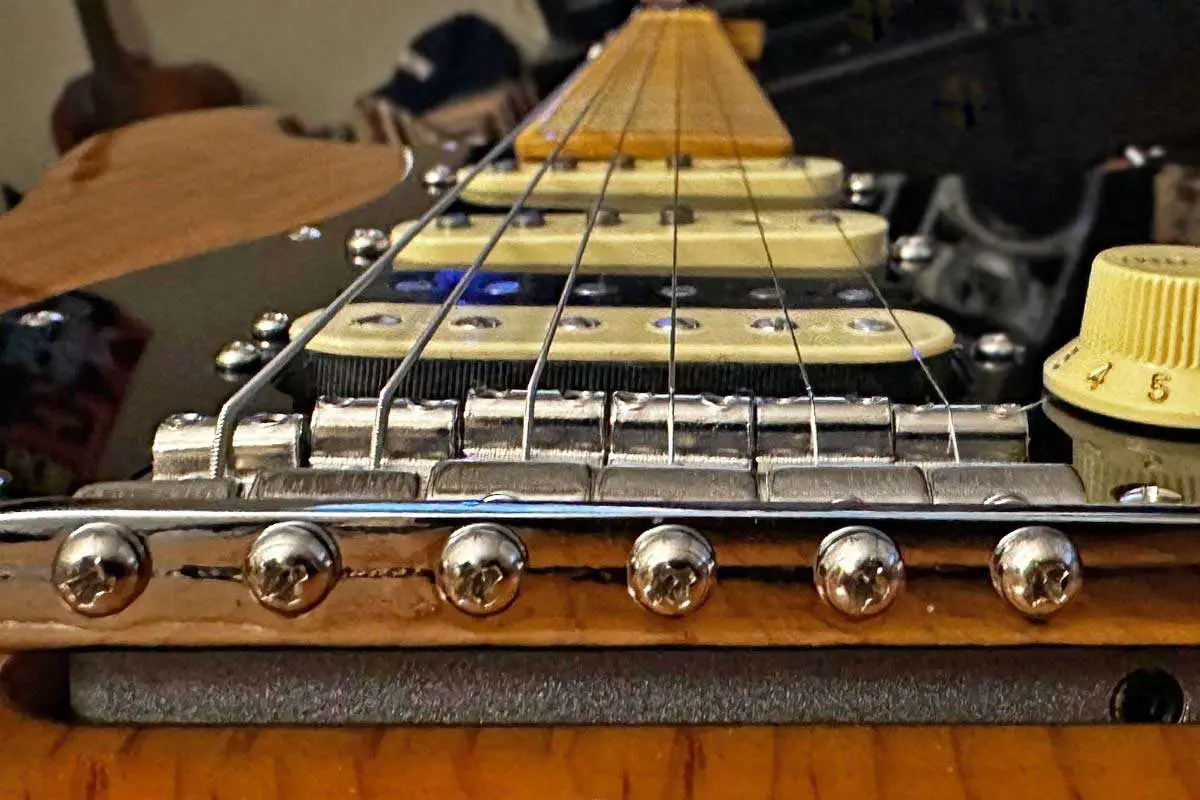
Bridge Types and Options
Your Stratocaster can come with different types of bridges, each offering unique characteristics and benefits. The Hardtail bridge, devoid of a tremolo system, is known for increased sustain and tuning stability. However, most Stratocasters feature a tremolo bridge, which allows you to modulate the pitch of your notes for expressive vibrato effects. The Classic Series Strats show a 2 point tremolo bridge with 2-1/16″ string spacing and 2-7/32″ post spacing, while different models may feature varying spacing and size dimensions.
Tremolo Mechanisms
The tremolo mechanism in your Stratocaster is integral for creating dynamic playing nuances. This system typically involves a spring-loaded bridge that moves back and forth, allowing you to change the pitch of the strings. The versatility of the tremolo system is one of the Stratocaster’s most definitive traits.
Whether it’s the slight warble for a bluesy touch or a dive bomb for a rock solo, your tremolo’s responsiveness is key. Also note, the saddle size can vary. For example, a 10.5 mm saddle may correspond to certain tremolo specifications like mount width and string spacing.
Electronics and Routing
Your Fender Stratocaster’s electronics and routing define not only the aesthetics but also the sonic character of the instrument. Precision in this area is crucial for proper hardware accommodation and the expected Stratocaster sound.
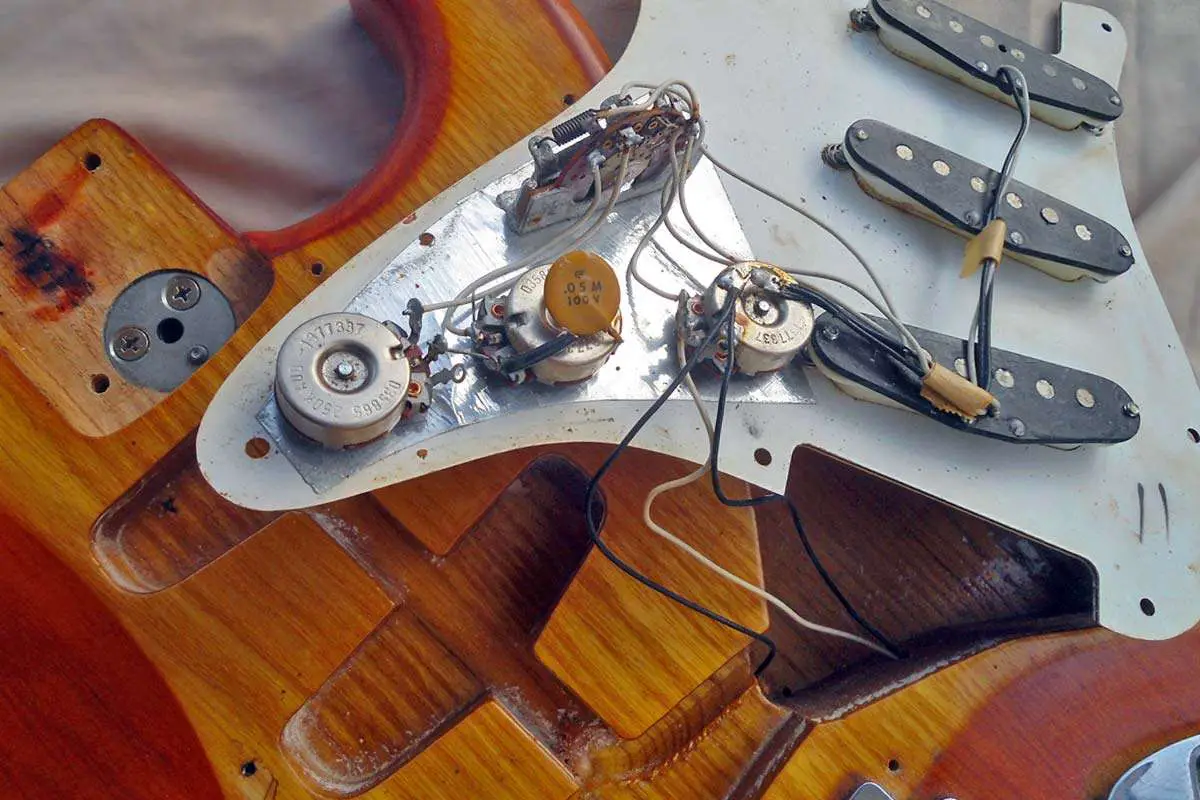
Pickup Configuration Variety
The Stratocaster is famed for its versatility, largely due to its range of pickup configurations. Typically, a Stratocaster comes with a single-coil setup (SSS) which is pivotal in achieving that bright, punchy tone the guitar is known for. The HSH pickup configuration combines humbuckers (H) and a single-coil (S) giving you a balance between thick, warm humbucker tones and the crisp clarity of single-coils.
Pre-Drilled Routing Standards
When examining a Stratocaster body, the pre-drilled routing is standardized to accommodate traditional Stratocaster hardware. This includes:
- Neck pickup cavity
- Middle pickup cavity
- Bridge pickup cavity
- Control cavity for volume and tone pots
- Channel for wiring
These cavities ensure a seamless fit for your pickups and electronics, leaving little room for error in standard models.
Custom Routing Possibilities
Customization enthusiasts might explore custom routing possibilities to fit non-standard pickups or additional hardware. This involves altering the standard cavities or creating new ones to accommodate different configurations like a double humbucker (HH) or adding extra switches or pots for more sound variety.
Remember, custom routing should preferably be done by professionals or with precise templates to maintain the structural integrity of your Stratocaster.
Customization and Replacement Bodies
When you’re looking to personalize or restore your Stratocaster, aftermarket bodies provide a pathway to modify both the aesthetics and sound of your guitar. From choosing the wood to deciding on the finish, you have the power to create a truly unique instrument.
Related: The Best Strings For Your Stratocaster
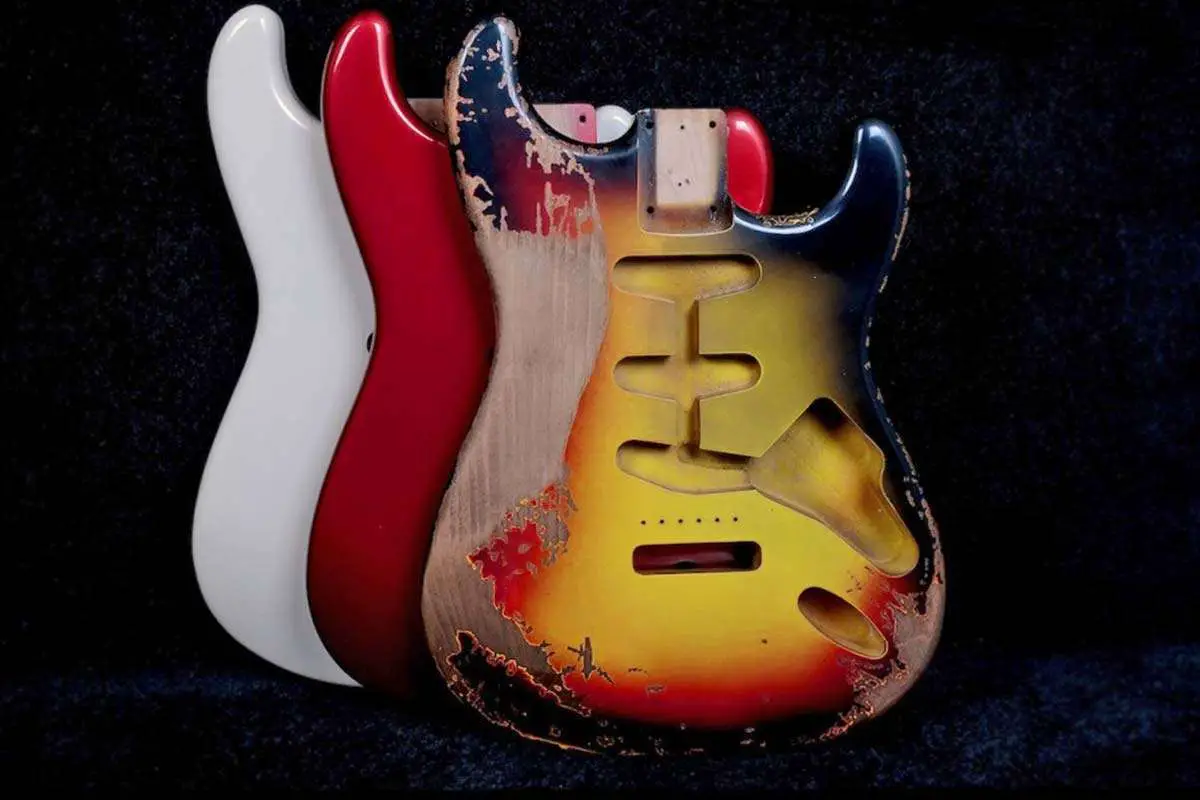
Aftermarket Options
Your journey into customization starts with a vast array of aftermarket options. Companies such as Warmoth offer Stratocaster replacement bodies in various woods, including the popular alder body. You have the choice to select from in-stock bodies or have one custom-built to specific requirements including wood type, finish, and pickup configurations.
- Wood Types: Alder, Ash, Mahogany
- Finishes: Gloss, Satin, Unfinished
- Pickup Routs: SSS, HSS, HSH
- Weight Range: Light to Heavy
Impact on Sound and Performance
The replacement body directly affects your Stratocaster’s sound and performance. An alder body is widely favored due to its balanced tone and resonance, making it a classic choice for various music genres. The type of wood and its density can alter the guitar’s sustain and frequency response, which is paramount for achieving your desired sound.
- Alder Body: Balanced with a slight upper-midrange emphasis
- Ash Body: Brighter with enhanced sustain
- Mahogany Body: Warm with more low-mid presence
Related: Installing a Treble Bleed Mod On Your Stratocaster
Installation and Fit
It’s crucial that the new body fits perfectly with your existing hardware. Ensure that the neck pocket is compatible with your Stratocaster’s neck dimensions and that the replacement body has the correct routing for your pickups and bridge. An exact fit guarantees optimal resonance and maintains the structural integrity of the guitar.
- Neck Pocket Fit: Standard Stratocaster size
- Bridge Fit: Compatible with existing Stratocaster hardware
- Pickup Fit: Ensure routs match your Stratocaster’s pickups
